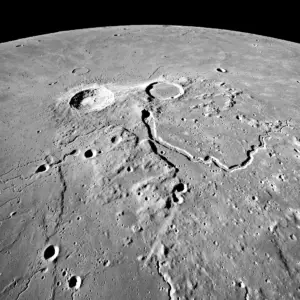If you’re like me and you’re fascinated by the night sky, you may start asking yourself questions like ‘How many craters are on the moon’. Now, one approach is to try and count them, but you’ll be there a long time! If you’ve ever tried to do this through your telescope or binoculars you will soon find this out the hard way.
So, how many craters are on the Moon? The official NASA press release announced that there are around 5,185 craters on the moon that are at least 20km in size. These scientists further propose that there are roughly 1 million craters bigger than 1km across and more than half a billion that surpass 16km.
Providing an exact number is increasingly difficult because the term crater can always be interpreted and understood differently.
The truth is, when you have large craters that are significant in size and clearly distinguishable its easy to count them towards the total.
However, what about all of those sites that are considerably smaller, are these still classified and considered craters?
Consequently, there is no absolute numbers that I am able to present to you here today – instead below are the current estimates concluded by scientists in the field:
** The 5,185 number was taken from the NASA Press Release, but the other two are estimates based on the work of others and are extrapolated from studies and data.
One thing we can see from this data is that as we classify craters at smaller and smaller sizes, the number we find increases quite significantly.
What Is A Crater?
A crater is defined as any spherically shaped cavity on the surface of a planet or moon.
This is generally caused by an on-surface explosion or the resulting aftermath of a collision with a comet, meteorite or other celestial body.

What Is the Largest Meteorite That Has Ever Hit The Moon?
Scientists in Spain announced in 2014 that the largest and brightest meteorite hit the moon in September 2013. It is the biggest collision recorded since records began.
The flash that emanated was bright enough to see from Earth; appearing as an afterglow for a full 8 seconds following the impact.
It is estimated that the space rock that collided with the surface was about 900 lbs and was traveling at more than 40,000 miles per hour when it made impact.
The meteorite has left a sizable crater and indentation that according to the scientists is just over 130 feet wide.
Why Do Meteorites Hit The Moon But Not The Earth?
Photographs of the moon provide proof and evidence that a meteorite hitting it is not an infrequent occurrence (they are more commonly smaller objects). But why then does Earth not suffer the same fate?
Although it is still possible and has happened throughout history, the moon does not have a meteor destroying atmosphere protecting it unlike earth.
The moon is, therefore, a lot more exposed and susceptible to being hit by objects propelling through space.
Who Monitors Crater Impact on the Moon?
The MIDAS Project (Moon Impact Detection and Analysis System) monitors the moons service and all the meteorites that hit its surface.
It has observatories in Spain that detect impact flashes on the moon.
Of particular interest to the project is identifying the rock clusters that strike both the Earth and the moon – especially when, where, and how they are coming from.
What Can Craters Tell Us About the Moon?
Since the invention and inception of the telescope, lunar craters have been used as a method to calculate the Moons Age.
This is because craters leave a permanent mark on the moon – they cannot be concealed due to the environment as is the case here on Earth.
So, by calculating the frequency of collision against how many meteorites hit, we can roughly estimate the age of the moon.
So how old is the moon estimated to be?
Based on the method outlined, it is estimated that the moon is around 4.40bn years old.
What is the Oldest Moon Crater?
Bailly is considered to be the oldest crater recorded – it is 303km in size! It is the aftermath of a collision that occurred 3 billion years ago (on scientific estimates).
It has numerous smaller craters inside its surface area, indicating that Bailly is in fact older than them. This is a technique often used to help identify the age of a crater.
It was named after the French astronomer Jean Bailly. When observing Bailly it appears closer and with less depth than it actually has.
The best time to try to observe it at a time near a full moon when the terminator crosses the crater wall.
Observing Moon Craters
If you want to observe moon craters through your own telescope, then one of the best ways is to purchase a Moon Filter.
This will provide contrast and will also enable you to see the smaller craters which would not observable without it.
You can get a number of affordable and often discounted Moon Filters on Amazon.
Orion has a great range of filters in particular.

Hey, my name is Jeremy. I’m a passionate and seasoned astronomer who loves nothing more than observing the night sky. I also love researching, learning, and writing all things Space and the Universe. I created Astronomy Scope to share my knowledge, experience, suggestions, and recommendations of what I have learned along the way while helping anyone to get into and maximize their enjoyment of the hobby.

